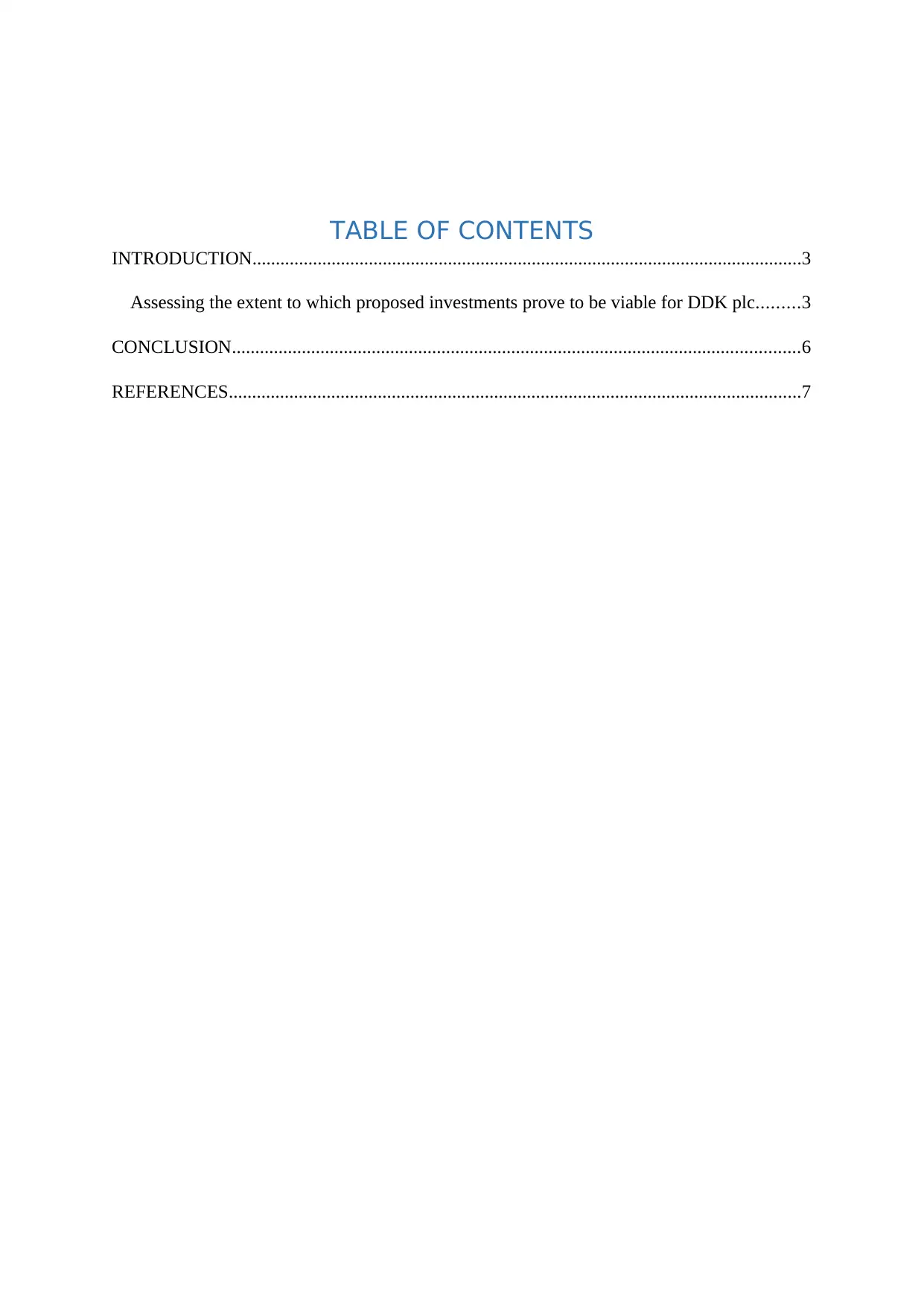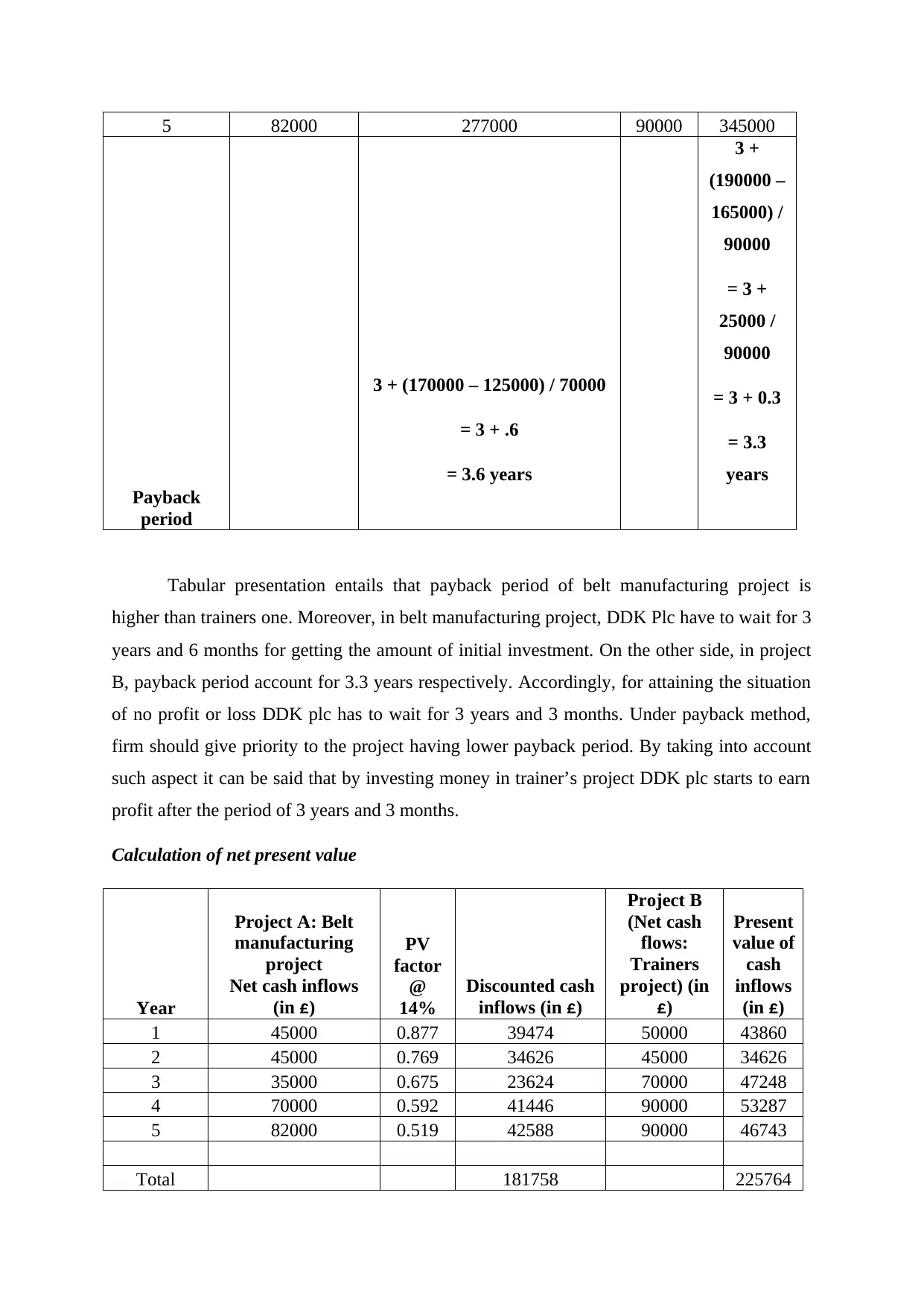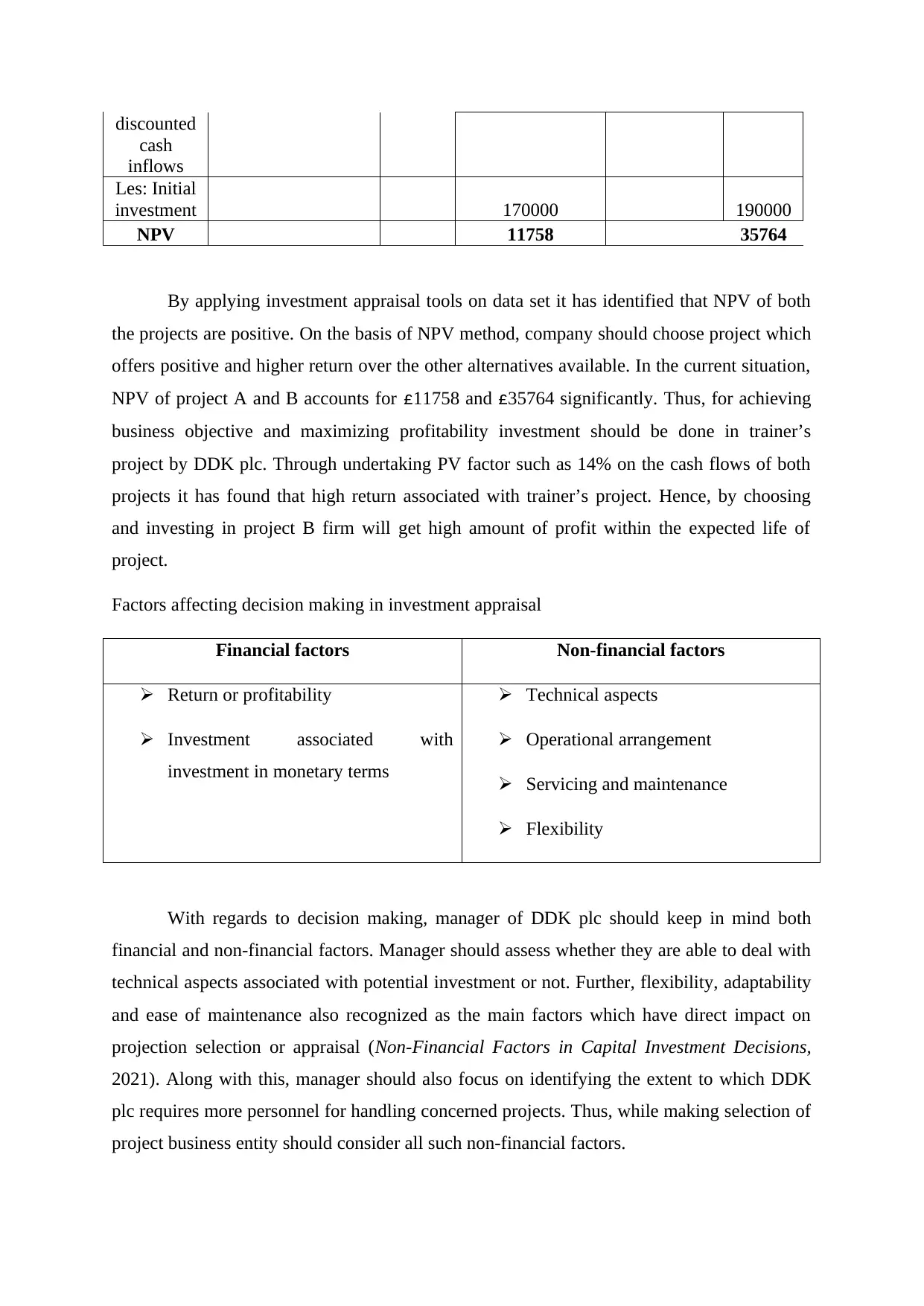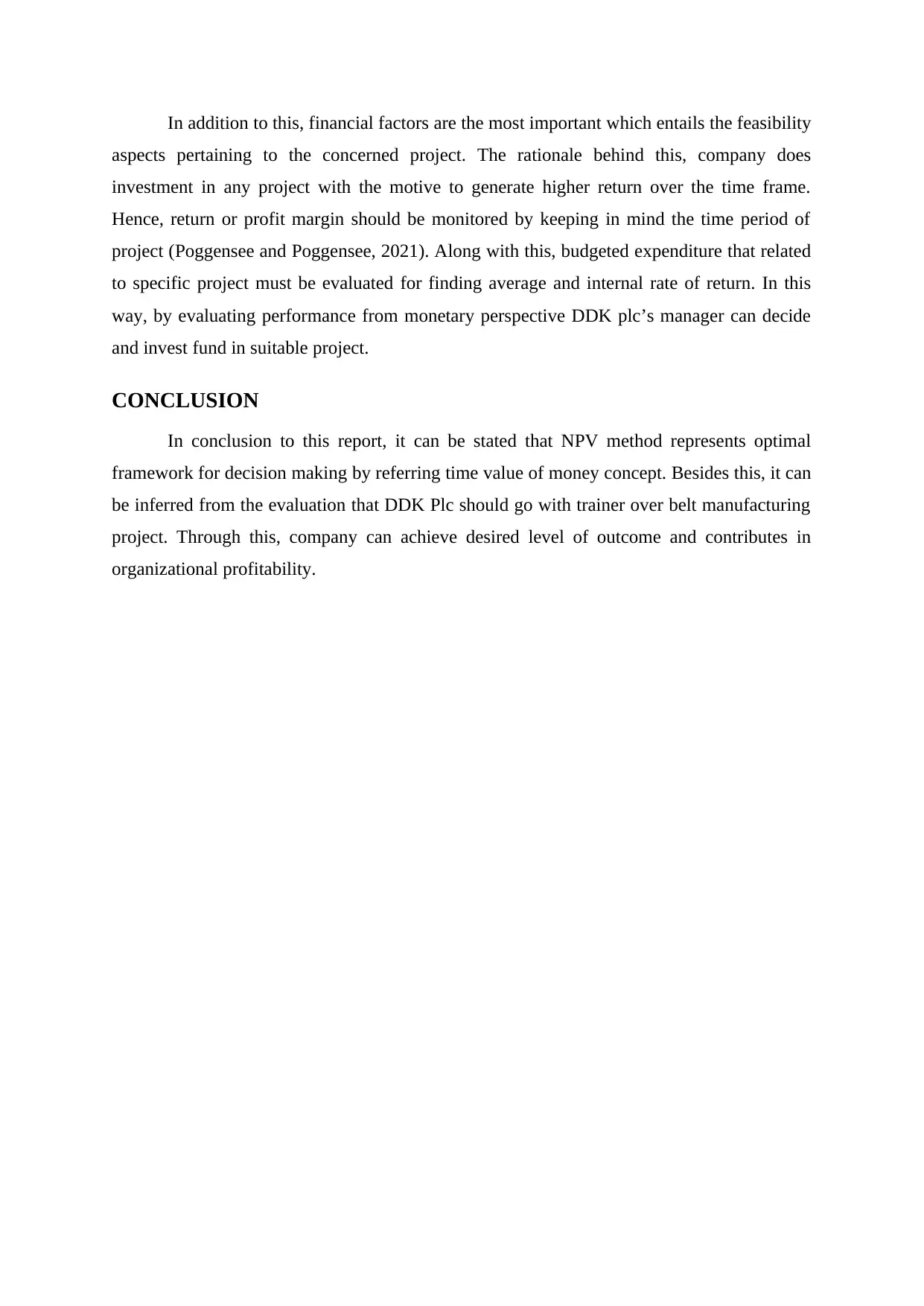DDK plc: Assessing Investment Viability Through Appraisal Techniques
VerifiedAdded on 2022/11/30
|7
|1214
|292
Report
AI Summary
This report assesses the viability of proposed investments for DDK plc, a textile company, focusing on project selection for expansion. The analysis employs investment appraisal techniques, primarily payback period and net present value (NPV), to evaluate two potential projects: belt manufacturing and trainers. The payback method determines the time required to recover the initial investment, indicating that the trainers project has a shorter payback period. The NPV method, considering a 14% discount rate, reveals positive NPVs for both projects, with the trainers project showing a significantly higher NPV. The report emphasizes the importance of both financial and non-financial factors in decision-making, including return on investment, technical aspects, operational arrangements, and flexibility. The conclusion recommends that DDK plc prioritize the trainers project to maximize profitability and achieve its business objectives. The report also includes references to relevant sources.

Business Decision Making
Paraphrase This Document
Need a fresh take? Get an instant paraphrase of this document with our AI Paraphraser

TABLE OF CONTENTS
INTRODUCTION......................................................................................................................3
Assessing the extent to which proposed investments prove to be viable for DDK plc.........3
CONCLUSION..........................................................................................................................6
REFERENCES...........................................................................................................................7
INTRODUCTION......................................................................................................................3
Assessing the extent to which proposed investments prove to be viable for DDK plc.........3
CONCLUSION..........................................................................................................................6
REFERENCES...........................................................................................................................7

INTRODUCTION
In the current times, effective decision making becomes crucial for an organization
for building and sustaining competitive edge over others. In this regard, manager is required
to make evaluation of all the alternative available and take appropriate decision which aid in
organizational success. The current report is based on the case scenario of DDK plc which
deals in textiles and planning to explore operations for achieving success. Thus, report will
provide deeper insight about the project which DDK Plc should select with the help of
investment appraisal techniques.
Assessing the extent to which proposed investments prove to be viable for DDK plc
Investment appraisal may be defined as a strategic financial analysis tool which
emphasizes on analysing the attractiveness of potential investments. In this regard, there
several techniques which can be employed by DDK Plc for assessing the investment viability.
Hence, such techniques mainly include payback period, net present value, average and
internal rate of return which indicates financial viability of concerned projects (What is
investment appraisal, 2021). On the basis of current case, business unit is applying payback
and net present value method for identifying the option which prove to be more beneficial.
Payback method entails time period associated with the recovery of initial investment
(Alkaraan, 2017). Hence, by taking into account the results of payback method DDK Plc can
do profit planning in the best possible way. Along with this. NPV method entails return
which business entity of DDK Plc will get after the period of five years using time value of
money concept.
Payback period assessment
Year
Project A (in
£)
Cumulative Net cash inflows
(in £)
Project
B (Net
cash
flows:
Traine
rs
project
)
Cumulati
ve Net
cash
inflows
(in £)
1 45000 45000 50000 50000
2 45000 90000 45000 95000
3 35000 125000 70000 165000
4 70000 195000 90000 255000
In the current times, effective decision making becomes crucial for an organization
for building and sustaining competitive edge over others. In this regard, manager is required
to make evaluation of all the alternative available and take appropriate decision which aid in
organizational success. The current report is based on the case scenario of DDK plc which
deals in textiles and planning to explore operations for achieving success. Thus, report will
provide deeper insight about the project which DDK Plc should select with the help of
investment appraisal techniques.
Assessing the extent to which proposed investments prove to be viable for DDK plc
Investment appraisal may be defined as a strategic financial analysis tool which
emphasizes on analysing the attractiveness of potential investments. In this regard, there
several techniques which can be employed by DDK Plc for assessing the investment viability.
Hence, such techniques mainly include payback period, net present value, average and
internal rate of return which indicates financial viability of concerned projects (What is
investment appraisal, 2021). On the basis of current case, business unit is applying payback
and net present value method for identifying the option which prove to be more beneficial.
Payback method entails time period associated with the recovery of initial investment
(Alkaraan, 2017). Hence, by taking into account the results of payback method DDK Plc can
do profit planning in the best possible way. Along with this. NPV method entails return
which business entity of DDK Plc will get after the period of five years using time value of
money concept.
Payback period assessment
Year
Project A (in
£)
Cumulative Net cash inflows
(in £)
Project
B (Net
cash
flows:
Traine
rs
project
)
Cumulati
ve Net
cash
inflows
(in £)
1 45000 45000 50000 50000
2 45000 90000 45000 95000
3 35000 125000 70000 165000
4 70000 195000 90000 255000
⊘ This is a preview!⊘
Do you want full access?
Subscribe today to unlock all pages.

Trusted by 1+ million students worldwide

5 82000 277000 90000 345000
Payback
period
3 + (170000 – 125000) / 70000
= 3 + .6
= 3.6 years
3 +
(190000 –
165000) /
90000
= 3 +
25000 /
90000
= 3 + 0.3
= 3.3
years
Tabular presentation entails that payback period of belt manufacturing project is
higher than trainers one. Moreover, in belt manufacturing project, DDK Plc have to wait for 3
years and 6 months for getting the amount of initial investment. On the other side, in project
B, payback period account for 3.3 years respectively. Accordingly, for attaining the situation
of no profit or loss DDK plc has to wait for 3 years and 3 months. Under payback method,
firm should give priority to the project having lower payback period. By taking into account
such aspect it can be said that by investing money in trainer’s project DDK plc starts to earn
profit after the period of 3 years and 3 months.
Calculation of net present value
Year
Project A: Belt
manufacturing
project
Net cash inflows
(in £)
PV
factor
@
14%
Discounted cash
inflows (in £)
Project B
(Net cash
flows:
Trainers
project) (in
£)
Present
value of
cash
inflows
(in £)
1 45000 0.877 39474 50000 43860
2 45000 0.769 34626 45000 34626
3 35000 0.675 23624 70000 47248
4 70000 0.592 41446 90000 53287
5 82000 0.519 42588 90000 46743
Total 181758 225764
Payback
period
3 + (170000 – 125000) / 70000
= 3 + .6
= 3.6 years
3 +
(190000 –
165000) /
90000
= 3 +
25000 /
90000
= 3 + 0.3
= 3.3
years
Tabular presentation entails that payback period of belt manufacturing project is
higher than trainers one. Moreover, in belt manufacturing project, DDK Plc have to wait for 3
years and 6 months for getting the amount of initial investment. On the other side, in project
B, payback period account for 3.3 years respectively. Accordingly, for attaining the situation
of no profit or loss DDK plc has to wait for 3 years and 3 months. Under payback method,
firm should give priority to the project having lower payback period. By taking into account
such aspect it can be said that by investing money in trainer’s project DDK plc starts to earn
profit after the period of 3 years and 3 months.
Calculation of net present value
Year
Project A: Belt
manufacturing
project
Net cash inflows
(in £)
PV
factor
@
14%
Discounted cash
inflows (in £)
Project B
(Net cash
flows:
Trainers
project) (in
£)
Present
value of
cash
inflows
(in £)
1 45000 0.877 39474 50000 43860
2 45000 0.769 34626 45000 34626
3 35000 0.675 23624 70000 47248
4 70000 0.592 41446 90000 53287
5 82000 0.519 42588 90000 46743
Total 181758 225764
Paraphrase This Document
Need a fresh take? Get an instant paraphrase of this document with our AI Paraphraser

discounted
cash
inflows
Les: Initial
investment 170000 190000
NPV 11758 35764
By applying investment appraisal tools on data set it has identified that NPV of both
the projects are positive. On the basis of NPV method, company should choose project which
offers positive and higher return over the other alternatives available. In the current situation,
NPV of project A and B accounts for £11758 and £35764 significantly. Thus, for achieving
business objective and maximizing profitability investment should be done in trainer’s
project by DDK plc. Through undertaking PV factor such as 14% on the cash flows of both
projects it has found that high return associated with trainer’s project. Hence, by choosing
and investing in project B firm will get high amount of profit within the expected life of
project.
Factors affecting decision making in investment appraisal
Financial factors Non-financial factors
Return or profitability
Investment associated with
investment in monetary terms
Technical aspects
Operational arrangement
Servicing and maintenance
Flexibility
With regards to decision making, manager of DDK plc should keep in mind both
financial and non-financial factors. Manager should assess whether they are able to deal with
technical aspects associated with potential investment or not. Further, flexibility, adaptability
and ease of maintenance also recognized as the main factors which have direct impact on
projection selection or appraisal (Non-Financial Factors in Capital Investment Decisions,
2021). Along with this, manager should also focus on identifying the extent to which DDK
plc requires more personnel for handling concerned projects. Thus, while making selection of
project business entity should consider all such non-financial factors.
cash
inflows
Les: Initial
investment 170000 190000
NPV 11758 35764
By applying investment appraisal tools on data set it has identified that NPV of both
the projects are positive. On the basis of NPV method, company should choose project which
offers positive and higher return over the other alternatives available. In the current situation,
NPV of project A and B accounts for £11758 and £35764 significantly. Thus, for achieving
business objective and maximizing profitability investment should be done in trainer’s
project by DDK plc. Through undertaking PV factor such as 14% on the cash flows of both
projects it has found that high return associated with trainer’s project. Hence, by choosing
and investing in project B firm will get high amount of profit within the expected life of
project.
Factors affecting decision making in investment appraisal
Financial factors Non-financial factors
Return or profitability
Investment associated with
investment in monetary terms
Technical aspects
Operational arrangement
Servicing and maintenance
Flexibility
With regards to decision making, manager of DDK plc should keep in mind both
financial and non-financial factors. Manager should assess whether they are able to deal with
technical aspects associated with potential investment or not. Further, flexibility, adaptability
and ease of maintenance also recognized as the main factors which have direct impact on
projection selection or appraisal (Non-Financial Factors in Capital Investment Decisions,
2021). Along with this, manager should also focus on identifying the extent to which DDK
plc requires more personnel for handling concerned projects. Thus, while making selection of
project business entity should consider all such non-financial factors.

In addition to this, financial factors are the most important which entails the feasibility
aspects pertaining to the concerned project. The rationale behind this, company does
investment in any project with the motive to generate higher return over the time frame.
Hence, return or profit margin should be monitored by keeping in mind the time period of
project (Poggensee and Poggensee, 2021). Along with this, budgeted expenditure that related
to specific project must be evaluated for finding average and internal rate of return. In this
way, by evaluating performance from monetary perspective DDK plc’s manager can decide
and invest fund in suitable project.
CONCLUSION
In conclusion to this report, it can be stated that NPV method represents optimal
framework for decision making by referring time value of money concept. Besides this, it can
be inferred from the evaluation that DDK Plc should go with trainer over belt manufacturing
project. Through this, company can achieve desired level of outcome and contributes in
organizational profitability.
aspects pertaining to the concerned project. The rationale behind this, company does
investment in any project with the motive to generate higher return over the time frame.
Hence, return or profit margin should be monitored by keeping in mind the time period of
project (Poggensee and Poggensee, 2021). Along with this, budgeted expenditure that related
to specific project must be evaluated for finding average and internal rate of return. In this
way, by evaluating performance from monetary perspective DDK plc’s manager can decide
and invest fund in suitable project.
CONCLUSION
In conclusion to this report, it can be stated that NPV method represents optimal
framework for decision making by referring time value of money concept. Besides this, it can
be inferred from the evaluation that DDK Plc should go with trainer over belt manufacturing
project. Through this, company can achieve desired level of outcome and contributes in
organizational profitability.
⊘ This is a preview!⊘
Do you want full access?
Subscribe today to unlock all pages.

Trusted by 1+ million students worldwide

REFERENCES
Books and Journals
Alkaraan, F., 2017. Strategic investment appraisal: multidisciplinary perspectives.
In Advances in Mergers and Acquisitions. Emerald Publishing Limited.
Poggensee, K. and Poggensee, J., 2021. Selection of Alternatives and Investment Programme
Planning. In Investment Valuation and Appraisal (pp. 141-202). Springer, Cham.
Online
Non-Financial Factors in Capital Investment Decisions. 2021. Online. Available through: <
https://www.accountingnotes.net/financial-management/capital-budgeting/non-financial-
factors-in-capital-investment-decisions/10949>.
What is investment appraisal? 2021. Online. Available through: <
https://www.ig.com/uk/glossary-trading-terms/investment-appraisal-definition>.
Books and Journals
Alkaraan, F., 2017. Strategic investment appraisal: multidisciplinary perspectives.
In Advances in Mergers and Acquisitions. Emerald Publishing Limited.
Poggensee, K. and Poggensee, J., 2021. Selection of Alternatives and Investment Programme
Planning. In Investment Valuation and Appraisal (pp. 141-202). Springer, Cham.
Online
Non-Financial Factors in Capital Investment Decisions. 2021. Online. Available through: <
https://www.accountingnotes.net/financial-management/capital-budgeting/non-financial-
factors-in-capital-investment-decisions/10949>.
What is investment appraisal? 2021. Online. Available through: <
https://www.ig.com/uk/glossary-trading-terms/investment-appraisal-definition>.
1 out of 7
Related Documents
Your All-in-One AI-Powered Toolkit for Academic Success.
+13062052269
info@desklib.com
Available 24*7 on WhatsApp / Email
![[object Object]](/_next/static/media/star-bottom.7253800d.svg)
Unlock your academic potential
Copyright © 2020–2025 A2Z Services. All Rights Reserved. Developed and managed by ZUCOL.





